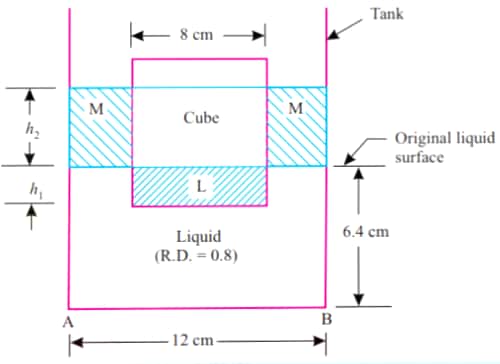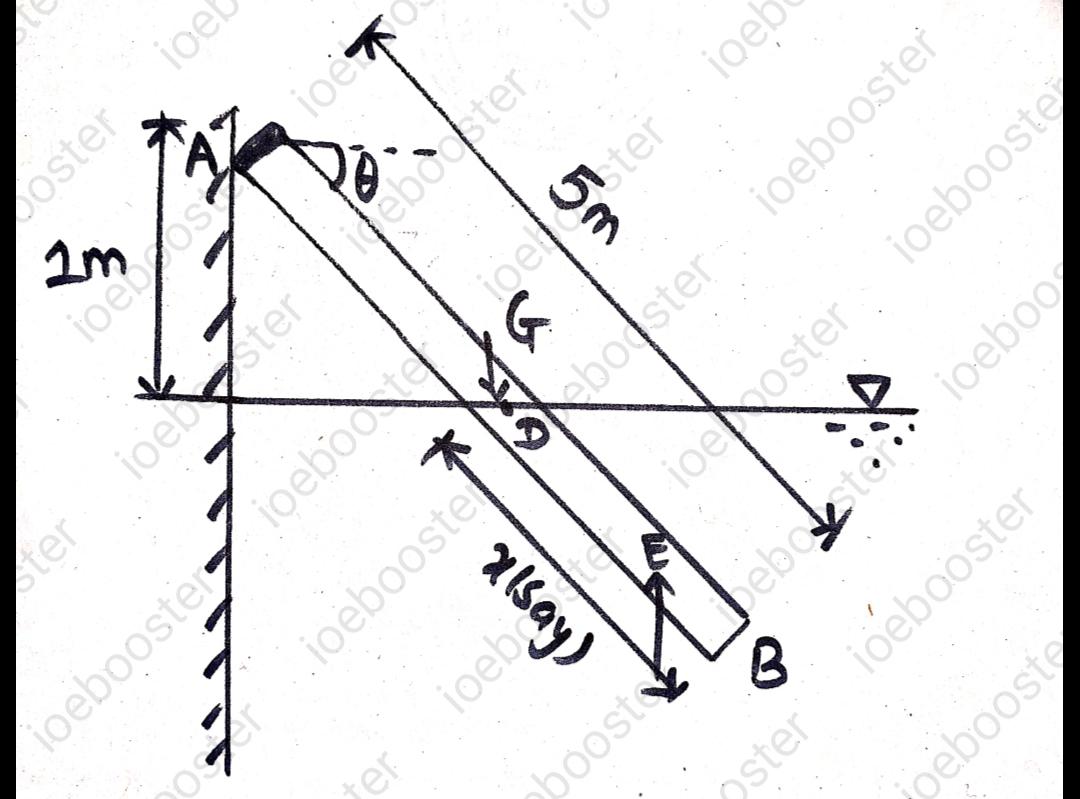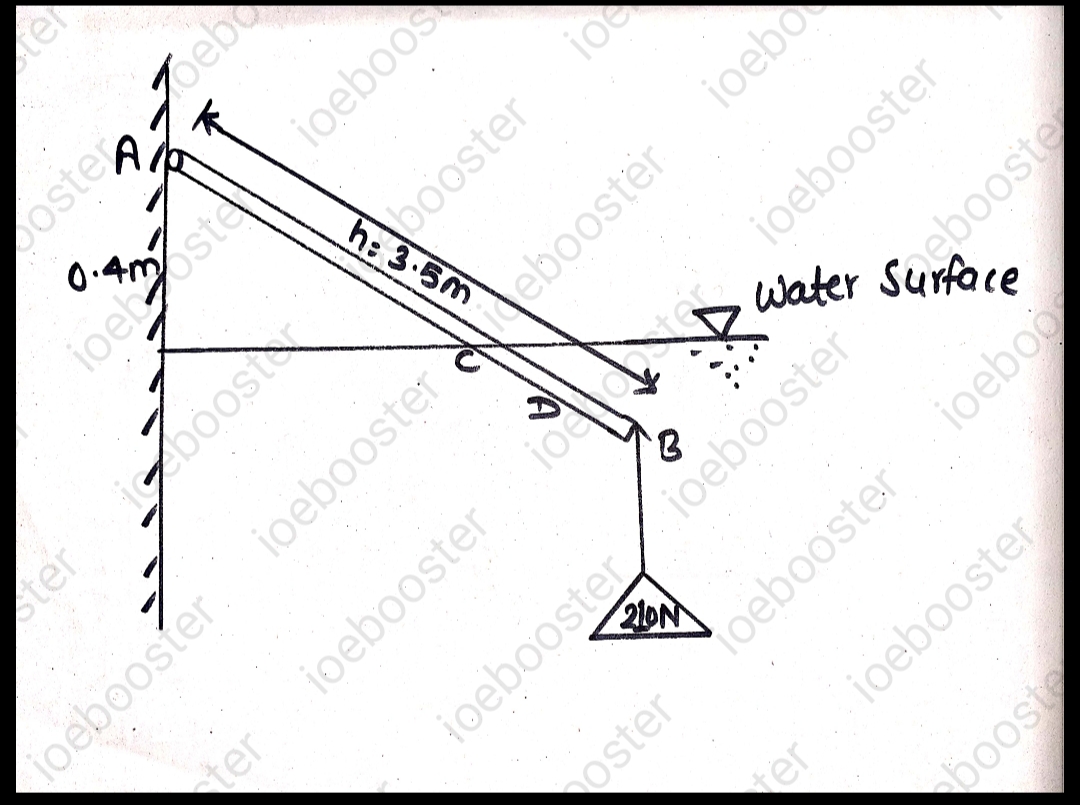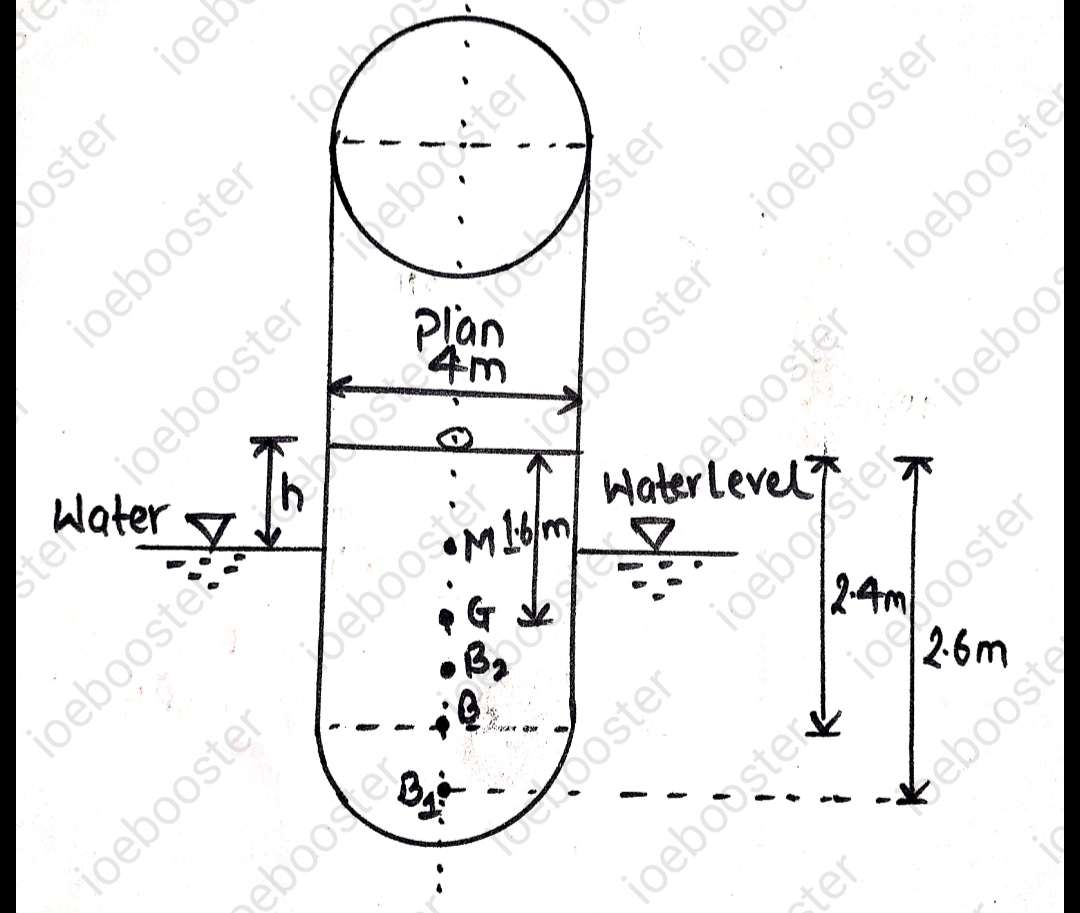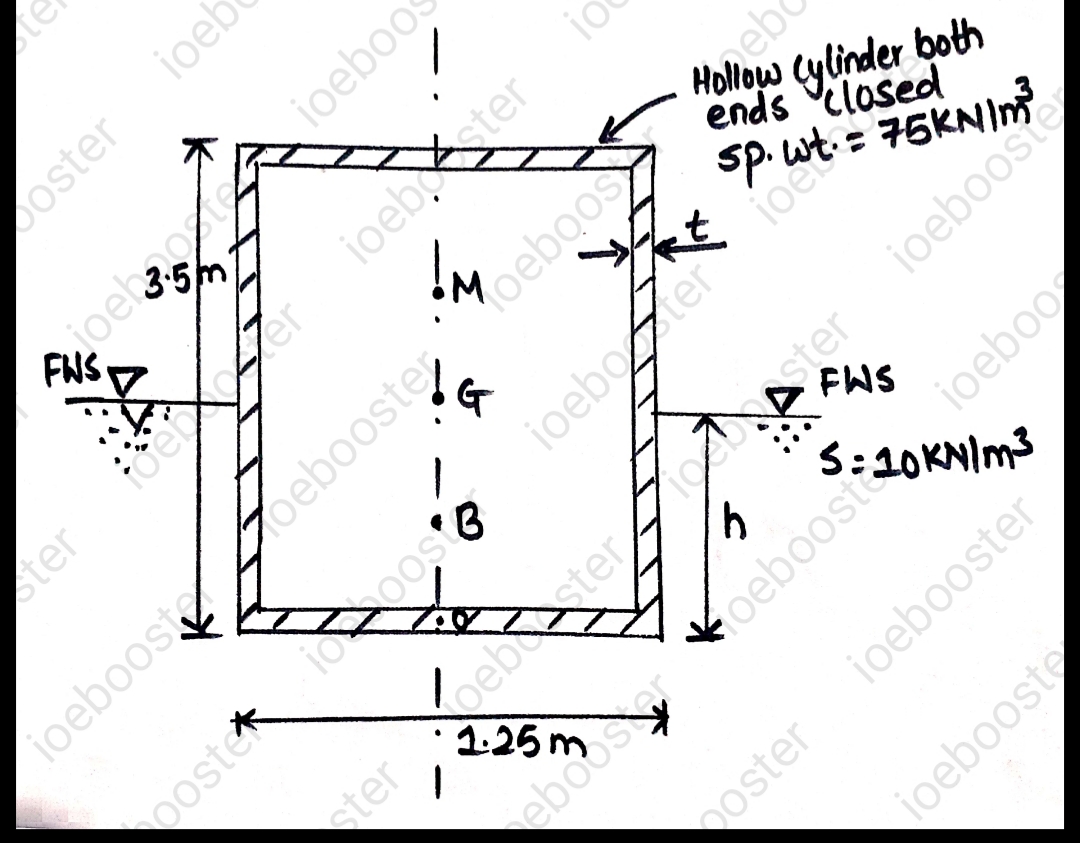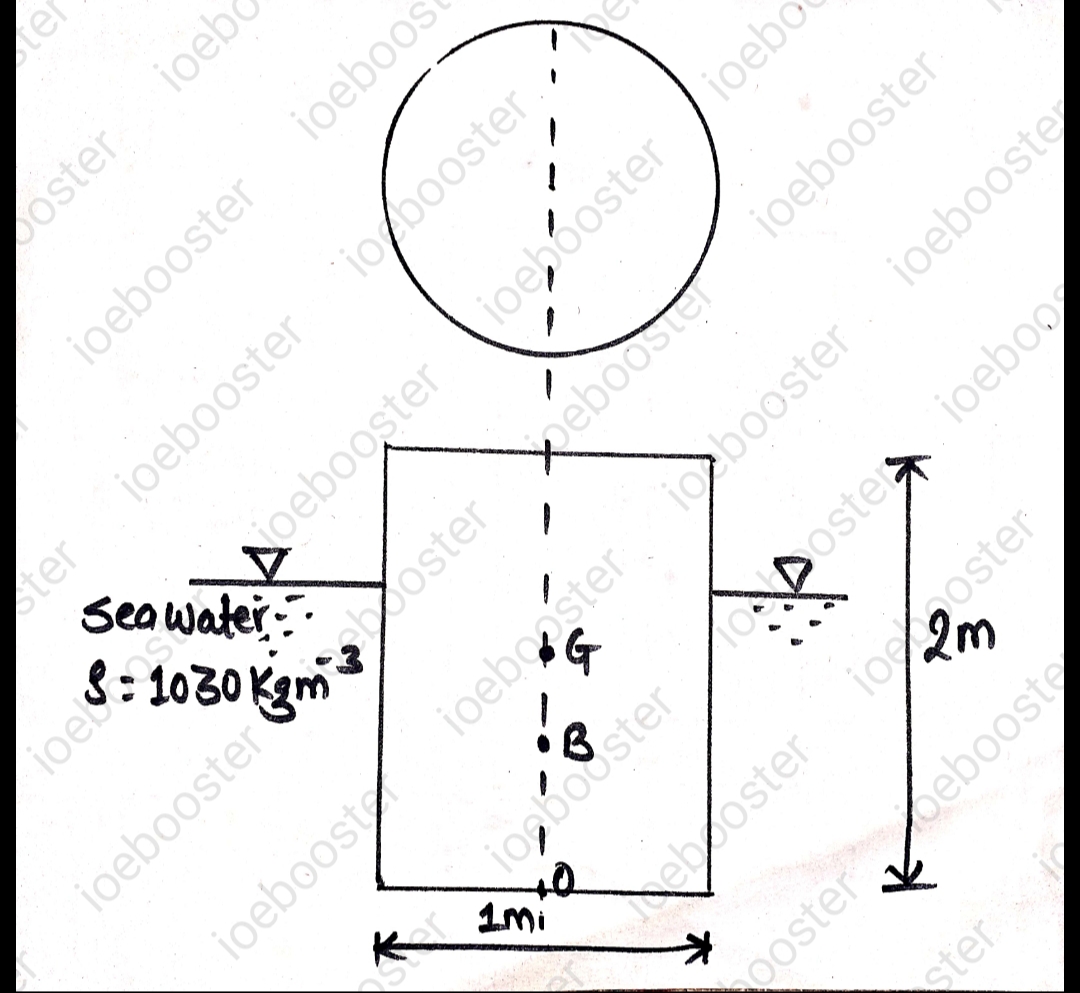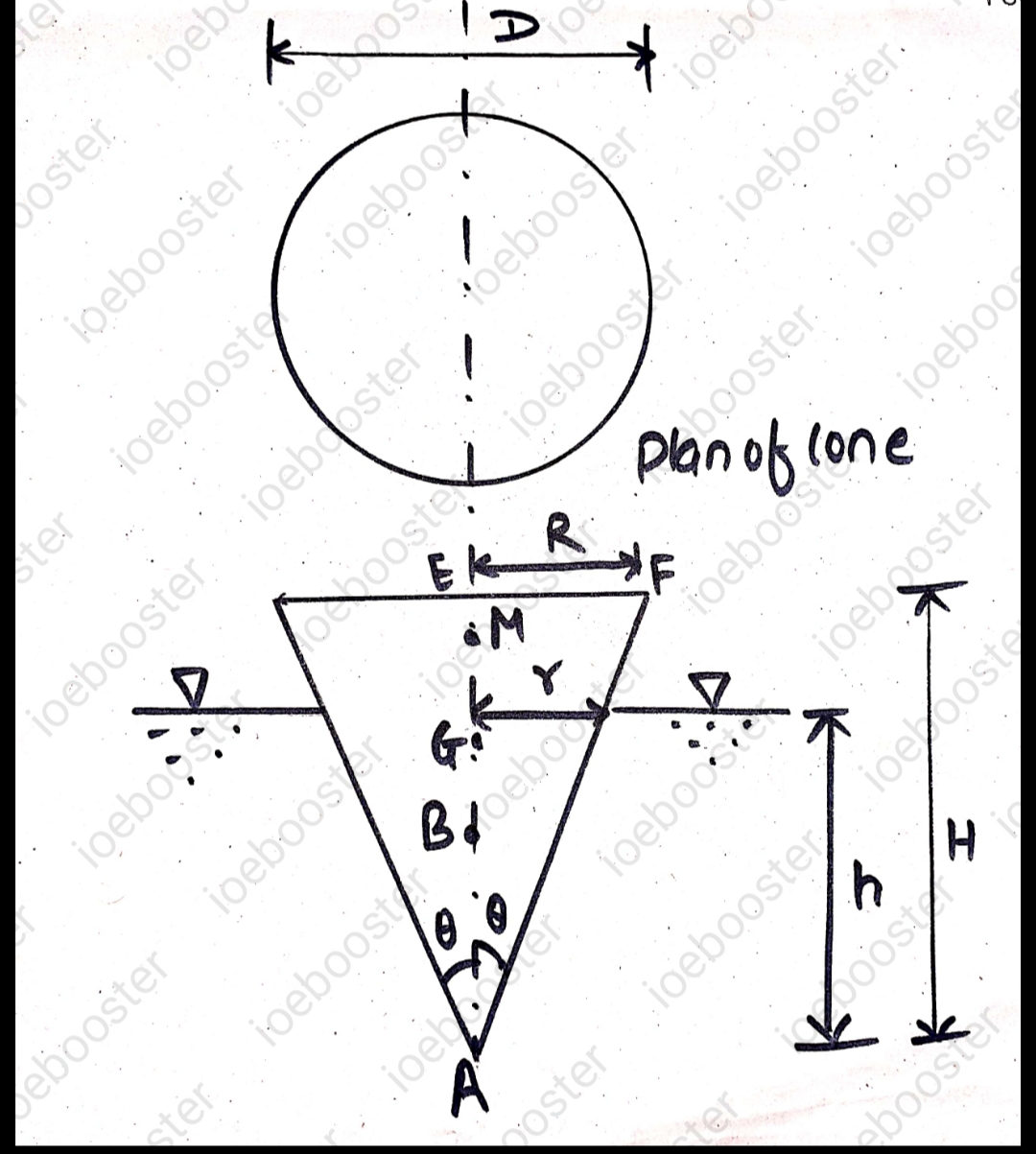Chapter:
1. A wooden log of 0.6 m diameter and 5m in length is floating in river water. Find depth of wooden log in water when specific gravity of log is 0.7.
SOLUTION:
Given,
Diameter of wooden log, `D=0.6 m`
Length of log,`L=5 m`
Specific gravity of log,`S=0.7`
Here,
Weight of wooden log `=V*rhog`
`=A*L*rhog`
`=pi/4**0.6^2**5**0.7**1000**9810`
`=9707.99 N`
Now, for equilibrium,
Weight of wooden log = weight of water displaced
=Volume of water displaced ** weight density
or, volume of water displaced `=9707.99/(9.81**1000)`
`=0.9896 m^3`
Let h be the depth of immersion.
Now,
Volume of log inside water = volume of water displaced
or, area of ACDA ** Length =0.9896
or, area of sector OADC + area of `triangle AOC` = `0.9896/5`
or,`pi**0.3^2**(180+2theta)/360+½*rsintheta*(rcostheta+rcostheta)=0.9896/5`
Solving this, we get,
`theta=18.64^0`
Again from figure,
`h=r+rsintheta`
`=0.3959 m`
2. A metallic cube 30 cm side and weighing 450 N is lowered into a tank containing a two layer fluid of water and mercury. Determine position of block at mercury-water interface at equilibrium condition. [ANNA UNIVERSITY ]
SOLUTION:
Given,
Side length of cube,`L=30 cm=0.3m`
Weight of metallic cube, `W=450 N`
Now, From the principle of floatation,
Weight of cube = Buoyant force
=weight of water and mercury displaced by the block
or,`W=V_w*gamma_w+V_m*gamma_m`
or,`450=(0.3**0.3**h_1)**9810+13600**9.81**(0.3**0.3**h_2)`
or,`450=0.3**0.3**9.81**1000 (h_1+13.6h_2)`
or,`h_1+13.6h_2=0.5097`.... (i)
Again,from figure,
`h_1+h_2=0.3`.... (ii)
Solving equations (i) and (ii), we get,
`h_1=0.283 m`
`h_2=0.01658 m`
Thus,the block is 0.01658 m below the interface.
3. A 8 cm side cube weighing 4N is immersed in a liquid of relative density 0.8 contained in a rectangular tank of cross sectional area 12 cm ** 12 cm. If tank contains liquid to a height of 6.4 cm before immersion, determine levels of bottom of cube and liquid surface.
SOLUTION:
Given,
Side length of cube,`L=8 cm=0.08m`
Weight of cube, `W=4 N`
Relative density of liquid ,`S=0.8`
Let,
`h_1` be the height to which the bottom of the cube falls below original liquid level
`h_2` be the height of rise of liquid above the original liquid surface
Thus, `h_1 + h_2` will be the depth of submergence of the cube.
Now, from figure,
Volume L = volume M�?� (i)
Where,
Volume L = `8**8**h_1`
And volume M = `12**12**h_2-8**8**h_2` (see figure)
Thus from equation (i),
or,`8**8**h_1=12**12**h_2-8**8**h_2`
or,`h_1=1.25h_2`... (ii)
Also, From the law of floatation,
Weight of cube = Buoyant force
=weight of water displaced by immersed portion
or,`4=0.8**9.81**1000**8**8 (h_1+h_2)**10^(-6)`
or,`h_1+h_2=7.9638`... (iii)
Now, from equations (ii) and (iii),
`h_1=4.424 cm`
`h_2=3.5395 cm`
Thus the level of cube above BC is
`=6.4-4.424`
`=1.976 cm`
Also the level of liquid surface above plane BC is,
`=6.4+3.5395`
`=9.94 cm`
4. The wooden beam shown in figure is 200 mm ** 200 mm ** 5 m long. It is hinged at A and remains in equilibrium at `ta` with horizontal. Find inclination `ta`. The specific gravity of wood can be taken as 0.70.
SOLUTION:
Let, the specific weight of water `=w`
Thus, the specific weight of wood becomes `0.6w`
Let `x m` length of the beam is immersed under water as shown in figure.
Now, the weight of the beam acting at point G i.e, c.g. of the beam is,
`=V*rho*g`
`=0.2**0.2**5**0.6w`
`=0.12w`N
Similarly the upthrust on the wooden beam is,
`=V_(in)*rho_w*g`
`=0.2**0.2**x.w`
`=0.04 wx` N
This upthrust acts at point E i.e, at the point of centre of buoyancy.
`AG=5/2=2.5`
`AE=5-x/2`
Now, taking moments about the hinge A, we get,
`0.12w**2.5 costheta=0. 04 wx (5-x/2)costheta`
or,`0.3=0.20x-0.02x^2`
Solving this, we get,
`x=1.838 m`
Also,
`sintheta=1/(5-1.838)`
or,`theta=18^0 26'`
5. A wooden block of volume `0.03 m^3` weighing 210 N is attached to one end of a 3.5 m long wooden rod are under hinged to a wall. The block and part of rod are under water in position shown in figure. Find inclination `ta` of rod with horizontal. The rod weighs 15 N and has a uniform sectional area of 2000 `mm^2`.
SOLUTION:
Here,
Weight of the wooden block =210 N
Weight of the rod = 15 N
Thus, the upthrust on block is,
`=V*rho*g`
`=0.03**1000**9.81`
`=294.3`
Similarly,the upthrust on rod is,
`=V_(i n)*rho*g`
`=2000**10^(-6)**1000**9.81**(3.5-0.4/(sintheta))`
`=19.62 (3.5-0.4/(sintheta))`
Now, taking moment about A, we get,
`294.3**3.5 costheta+19.62 (3.5-0.4/(sintheta))**1/2 (3.5+0.4/(sintheta))*costheta=210**3.5costheta+15**3.5/2costheta`
or,`1030.05+9.81 (12.25-0.16/(sin^2theta))=735+26.25`
Solving this,we get,
`theta=3^0 28'`
6. Two spheres weighing 10 KN and 25 KN are each 1.6 m in diameter. They are connected by a short rope and placed in water. Find tension in connecting rope. Find also what portion of lighter sphere will protrude above water surface.
SOLUTION:
Here,
Considering the lower sphere,
Buoyant force = net downward force
or,`4/3pi**0.8^3**9.81**1=25-T`
or,`T=3.958 KN`
Similarly, Considering the upper sphere,
Buoyant force = net downward force
or,`(V_(i\n)*rho_w*g)/1000=10+T`
or,`V_(i\n)**9.81=10+3.958`
`V_(i\n)=1.4228 m^3`
Thus the volume above water is,
`=V-V_(i\n)`
`=4/3 pi**0.8^3-1.4228`
`=0.722 m^3`
Now, the percentage of volume above water is,
`=0.722/2.145 **100%`
`=33.66%`
7. A body has cylindrical upper portion of 4m diameter and 2.4 m deep. The lower portion, which is curved; displaces a volume of 800 litres of water and its centre of buoyancy is situated 2.6m below top of cylinder. The centre of gravity of whole body is 1.6 m below top of cylinder and total displacement of water is 52 KN. Find metacentric height of body.
SOLUTION:
Given,
Volume of water displaced by the lower portion =800 L
`=0.8 m^3`
Also the total displacement of the water =52 KN
Thus the total volume of water displaced is`=52/9.81=5.3 m^3`
Hence the volume of water displaced by the upper cylindrical portion is`=5.3-0.8=4.5 m^3`
Let h be the distance between free surface of liquid from top of the body.
Volume of water displaced by upper portion`=pi/4**4^2**(2.4-h)`
or,`4.5=pi**4**(2.4-h)`
or,`h=2.04 m`
Now the distance of centre of buoyancy of the cylindrical portion from the top is,
`OB_2=h+(2.4-h)/2=2.22 m`
Let B be the centre of buoyancy of the whole body,
`OB=((Volume\ of\ Curved\ po rtion**OB_1)+(Volume\ of\ Cyl i ndrical\ po rtion**OB_2))/(Total\ Volume\ of\ water\ displaced)`
`=(0.8**2.6+4.5**2.22)/(0.8+4.5)`
`=2.277 m`
Now,
`BG=OB-OG`
`=2.277-1.6`
`=0.677 m`
Also,
`BM=I_(yy)/V`
Where,
`I_(yy)`=M.I of the plane of the body at the water surface.
or,`I_(yy)`=M.I of the cylindrical portion (top portion) about its c.g.
`=pi/64**4^2`
`=12.566 m^4`
And `V`=total volume of liquid displaced
or,`V=5.3 m^3`
Thus,
`BM=12.566/5.3`
`=2.37 m`
Hence the metacentric height is,
`GM=BM-BG`
`=2.37-0.677`
`=1.693 m`
8. A hollow cylinder closed at both ends has an outside diameter of 1.25 m, length 3.5 m and specific weight 75 KN/`m^3`. If cylinder is to float just in stable equilibrium in sea water ( specific weight 10 KN/`m^3`), find its minimum permissible thickness.
SOLUTION:
Let,
h be the depth of immersion and t be the minimum possible thickness
Now, from the law of floatation,
Weight of cylinder = weight of water displaced
`V_(cyl i nder) **sp.weight=pi/4**1.25**h**10`
or,`(Volume\ of\ two\ end\ Section + Volume\ of\ Circ u lar Po rtion)*Sp.Wt.=pi/4**15.625h `
`{2**pi/4d^2t+pi/4 (d^2-(d-2t)^2)L}w_c=12.2718h`
Assuming `t < < L`
`{2**pi/4d^2t+pi/4 (d^2-(d^2-4dt+4t^2))L}w_c=12.2718h`
`{(pid^2t)/2+pi/4 (4dt)L}w_c=12.2718h`
`{(pi**1.25^2t)/2+pi**1.25tL}7.5=12.2718h`
`h=99t`
Now, Volume of seawater displaced is,
`V=((pi/2**1.25^2t+pi**1.25**t**3.5)7.5)/10`
`=121.5t`
Let M be the point ot metacentre.
Thus,
`BM=I_(yy)/V`
`=pi/64**1.25^4/(121.5t)`
`=0.00099/t`
`OB=h/2=49.5t`
`OG=3.5/2=1.75 m`
Now,
`BG=OG-OB`
`=1.75-49.5t`
Now for the cylinder to just float in stable equilibrium,
`GM=0`
or,`BM-BG=0`
`1.75-49.5t=0.00099/t`
Solving this we get two values of t as,
`t=0.03478` and `t=5.75**10^(-4)`
Clearly,
Minimum permissible thickness is, `t=5.75**10^(-4) m`
9. Show that a cylindrical buoy of 1m diameter and 2m height weighing 7.848 KN will not float vertically in sea water of density 1030 kg/`m^3`. Find force necessary in a vertical chain attached at centre of base of buoy that will keep it vertical.
SOLUTION:
Let,
h be the depth of immersion
Now, from law of Floatation,
Weight of cylinder = Buoyant force
`7.848=(pi**1^2)/4**h**1030**9.81**1/1000`
`h=0.9899 m`
Now, the distance of c.g. from base is,`=2/2=1m`
Similarly, the distance of C.B. from base is,`=h/2=0.49479`
Now,
`BG=OG-OB`
`=0.50503`
Now the metacentric height is,
`GM=I _(yy)/V-BG`
Where, `I_(yy)`=M.I of the plan about y axis.
`=(pid^4)/64`
And V=volume of cylinder immersed
`=(pid^2)/4*h`
Thus,
`GM=d^2/(16h)-0.50503`
`=1^2/(16**0.9899)-0.50503`
`=-0.442`
Here the negative sign shows that the metacentre lies below the centre of gravity and hence the cylinder will be in unstable equilibrium and hence the cylinder will not float vertically in water.
Let T force is applied in a vertical chain attached at the centre of base of buoy to keep the buoy vertical.
Now, we have to find the combined position of c.g. and C.B. For combined centre of buoyancy, let h' be the depth of immersion when force T is applied.
From the law of floatation,
Total downward force = weight of water displaced
`7848+T=(pid^2)/4*rho_w*h'*g`
`7848+T=pi/4**1^2**1030**h'**9.81`
`h'=(7848+T)/7935.89`
Now the distance of new C.B is,
`C.B=AB=h'/2=(7848+T)/15871.8`
Now
Let,
`W_c`be the weight of cylinder
`x_1` be the distance of c.g (weight acting point) from A
`x_2` be the distance of application of T force from A.
Now, the combined c.g. due to weight of cylinder and due to tension T in the chain from A is,
`AG'=(W_c*x_1+T*x_2)/(W_c+T)`
`=((7848**2/2)+(T**0))/(7848+T)`
`=7848/(7848+T)`
Also,
`B'G'=AG' - AB'`
`=7848/(7848+T) - (7848+T)/15871.8`
Now the metacentric height is,
`GM=I/V-B'G'`
`=(pid^4)/(64**(pid^2)/4*h') -B'G'`
`=1/(16h')-B'G'`
`=1/(16 **(7848+T)/7935.89)-7848/(7848+T) +(7848+T)/15871.8`
Now for stable equilibrium,
`GM >=0`
`=1/(16 **(7848+T)/7935.89)-7848/(7848+T) +(7848+T)/15871.8 >=0`
`-117632/(16 (7848+T))+(7848+T)/(15871.8)>=0`
`(7848+T)/(15871.8)>= 117632/(16 (7848+T))`
`(7848+T)^2 >=(1080.23^2)`
`7848+T>=1080.23`
`T>=2954.3 N`
Thus the force in the chain must be at least equal to 2954.3 N so that the cylindrical buoy can be kept in vertical position.
10. A solid cone floats in water with its apex downwards. Determine least apex angle of cone for stable equilibrium. The specific gravity of cone is 0.8.
SOLUTION:
Let,
D be the diameter of cone
d be the diameter of cone at water level
`2theta` be the apex angle of the cone
H be the height of cone
h be the depth of cone in water
G be the c.g. of the cone
B be the C.B. of the cone
We know that, for cone,
`AG=3/4H` and `AB=3/4h`
Also,
Volume of water displaced is,
`=1/3pir^2h`
And the volume of the cone is,
`=1/3piR^2H`
Thus the weight of the cone is,
`=800**9.81**1/3**piR^2H`
Now from `triangle AEF`,
`tantheta=R/H`
`R=H tantheta`
Similarly, `r=htantheta`
Thus the weight of cone is,
`=800g**1/3pi**(Htantheta)^2**H`
`=(800g**pi**H^3tan^2theta)/3`
Weight of water displaced is given as,
`=(1000g**pi**h^3tan^2theta)/3`
Now from the law of floatation,
Weight of cone = weight of water displaced
`(800g**pi**H^3tan^2theta)/3=(1000g**pi**h^3tan^2theta )/3`
`800H^3=100h^3`
`H/h=(10/8)^(�??)`
Also the metacentric height is,
`GM=I_(yy)/V-BG`
Where, `I_(yy)`=M.I of the plan at water line about y axis.
`=(pid^4)/64`
And V=volume of cone in water
`=1/3pir^2*h`
`=�??(pid^2h)/4`
And `BG=3/4 (H-h)`
Thus,
`GM=((pid^4)/64)/((pid^2h)/12)-3/4 (H-h)`
`=(12r^2)/(16h)-3/4(H-h)`
`=3/4htan^2theta-3/4 (H-h)`
For stability,
`GM >0`
`htan^2theta>H-h`
`1+tan^2theta>(10/8)^(�??)`
`theta>15^0 31'`
`2theta >31^0 3'`
Thus the minimum apex angle is `31^0 3'`.
All Chapters
Dimensional Analysis, Similitude and Physical Modelling
Flow Past Through Submerged Body
Boundary Layer Theory
Properties of fluid
- properties of fluids
- complete IOE solution on fluid mechanics
- Detailed description chapterwise
- Unlimited Numericals problem solved with updation daily
- And much more
Hydrostatics
- Hydrostatics basic theory
- All important Numericals
- IOE,PU, MIT,A.M.I.E,Delhi university,EUPS,Engineering service exam solved problems
- Detailed explanation
Hydrostatics- Buoyancy and metacentric height
- detailed explanation of force of buoyancy, metacentric height,stability of floating body
- unlimited numericals solved with updation weekly
- including IOE , PU, KU, GATE, MIT, ANNA UNIVERSITY,UPSC EXAM SOLUTIONS
- And much more
 Guest
Guest
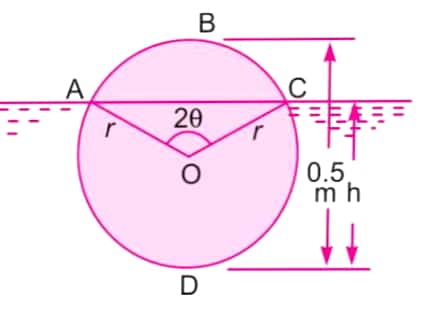
![A metallic cube 30 cm side and weighing 450 N is lowered into a tank containing a two layer fluid of water and mercury. Determine the position of block at mercury-water interface at equilibrium condition.\r\n[ANNA UNIVERSITY ]](/img-uploads/1579868816.jpg)
